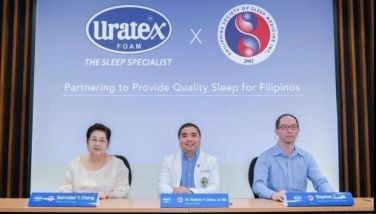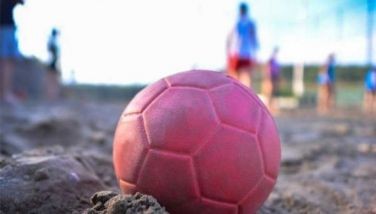PBA: Year one
The Philippine Basketball Association has been around for 40 years. Just to give you an idea of how long ago that was, Michael Jackson was still a child singing with his older brothers; Sharon Cuneta was still four years away from a recording career. The league’s minimum salary at the time was supposedly set at P2,500 a month, with some more established players getting P4,000 a month. There were no flyovers on EDSA, cable television and mobile phones did not exist in the Philippines, and several cities in Metro Manila were still municipalities. You had to open a cabinet, pull a knob and wait for a picture tube to warm up to watch television, and walk back across the room and turn another knob to change the channel.
As early as 1933, when the Philippines issued the world’s first basketball stamp, future Olympic team captain and Senator Ambrosio Padilla wrote “The ambition of every healthy boy now is to be a basketball player. His hero is no longer the baseballer but the basketballer.” It was a little premature considering Babe Ruth and Lou Gehrig would visit the country a couple of years later. In 1938, a group of successful businessmen wanted to create a new battlefield where they could indulge their passion for the game and earn bragging rights among themselves. From the late 1930’s until the early 1970’s, interrupted only by World War II and a few political upheavals, the Manila Inter-Commercial Athletic Association was the dominant commercial league in the Philippines.
The problem was that the MICAA was an amateur league, despite the compensaton package of the players. The Basketball Association of the Philippines, then the national association of the sport, borrowed the MICAA players frequently. In fact, largely due to the Asian Basketball Confederation tournament of 1974, the best players of Crispa, Toyota, Meralco, San Miguel and Yco were unable to see action for their mother teams at all. The team owners had finally had enough. Why pay for a team that is never complete, for star players you couldn’t use but paid for? There was only one way out back then: turn pro.
It would have been hard to predict the birth of the PBA, considering the political and economic atmosphere at the time. Then-President Ferdinand Marcos had declared Martial Law in 1972, imposing curfews and shutting down almost all private media outlets. A global fuel crisis followed, and from 1973 to 1974, the price of oil quadrupled. Against this backdrop, the PBA could have been seen as a poorly-timed display of ostentation by a small group of rich businessmen. But as it turned out, it was just what a weary citizenry needed.
The team owners were unanimous. There was only one man for the job of building the league’s foundation in its infant years, a dignified, soft-spoken gentle but firm businessman named Leo Prieto, who was universally respected for his fairness and for always holding sacred the welfare of all, favoring no one. Prieto, in turn, asked only two things: that he receive no salary and thus be beholden to no one, and that he be allowed to hire future commissioner Atty. Rudy Salud as the league’s first legal counsel. Jun Bernardino would join the team, and thus the PBA’s foundation was set.
And so on April 9, 1975 nine intrepid franchises paraded in the monolithic Araneta Coliseum, making the Philippine Basketball Association Asia’s first professional basketball league, with team names like the Seven-Up Uncolas, Concepcion Carrier Weathermen, Great Taste Coffee Makers, Mariwasa-Noritake Porcelain Makers, Tanduay Distillers, U-Tex Weavers, Toyota Comets, Royal Tru-Orange Orangemen, and last to join, the Crispa Redmanizers.
On that day, in front of over 18,000 curious fans, Joy Dionisio scored the PBA’s first basket as Mariwasa-Noritake defeated Concepcion Carrier 101-98. Later that evening, Toyota escaped a hard-fighting U-Tex, 105-101. The games themselves were beautiful to watch: raw, free-flowing, dynamic, breath-taking, but very, very physical, only for the most courageous of warriors. This was a generation that grew up playing basketball in the streets, finding their own identity in a sport that was, itself, passed on to Filipinos in its formative years. There was no technical training except for running and shooting. Team defense did not exist, and if someone scored on you, you could extract your point of flesh, literally.
But gradually, the players themselves realized that this was more than your neighborhood scrimmage: it was their livelihood, and they were playing before large audiences. As more and more of them started having families and committing to the game, they related to each other’s struggles, and eventually, stopped trying to hurting one another. Undercutting diminished, as did the frequent bone-jarring screens and teeth-rattling elbows. Well, a little bit.
But even in those rugged times, the PBA was already an endless source of inspiration for future generations who would mold the game and take it to the next level. Grand Slam San Mig Coffee coach Tim Cone was an adolescent, dreaming of playing in the PBA himself. A young chess player named Alvin Patrimonio decided to try this sport, and eventually became a four-time league MVP. Current commissioner Chito Salud was a teenaged ballboy, sitting beside first Commissioner Prieto. Talk N Text coach Jong Uichico admired and apired for the players’ recognition.
And as was the practice in the amateurs, foreign reinforcements, mostly American collegiate players or pros, were included to add variety and spice up the tournaments. In the PBA’s formative years, even gargantuan seven-foot imports were not uncommon, towering head and shoulders over local players. But this gave fans an electrifying thrill to see their average five-foot eight countrymen befuddle more credentialed Goliaths of the game with their creativity and guile, or as Filipinos call them “abilidad” and “diskarte”. This was where players like Danny Forencio flourished, creating shots that foreign players could not anticipate, or stop.
But it was the rivalry of two former MICAA titans, the Toyota Comets and Crispa Redmanizers, that fired up the public’s imagination. The multinational car brand led by Robert Jaworski, Mon Fernandez and Francis Arnaiz against the family-owned apparel company bannered by Bogs Adornado, Atoy Co and Abet Guidaben. Their brilliant scoring, breakneck pace, physical defense and intense dislike – some would say, hatred for each other – were always rabidly anticipated. On May 10, 1975 at the historic Rizal Memorial Coliseum, more than 11,000 screaming partisan spectators watched the Crispa-Floro Redmanizers and Toyota Comets battle for the first time as professionals. Bogs Adornado poured in 29 points as Crispa stopped Toyota’s seven-game winning streak, 139-133 – a fitting start to a mythic rivalry that would rule Philippine sports for the next decade.
Each season was divided into three tournaments or conferences. In the league’s maiden season, Toyota won the league’s first two conference championships over Crispa, and Crispa won the third conference over Toyota. The following year, Crispa would win a Grand Slam over Toyota.
And that was just year one.
- Latest
- Trending































